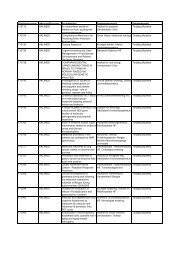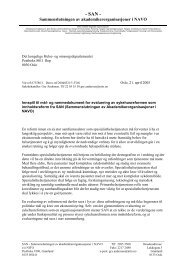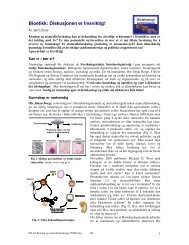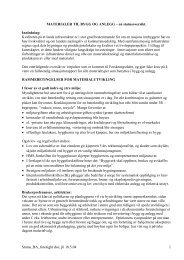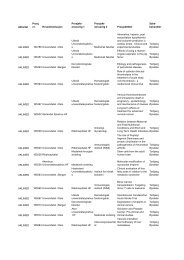A Revolution in R&D
A Revolution in R&D
A Revolution in R&D
You also want an ePaper? Increase the reach of your titles
YUMPU automatically turns print PDFs into web optimized ePapers that Google loves.
CASE STUDY: REDESIGNING R&D GOVERNANCE<br />
A large drug company recently completed an <strong>in</strong>tensive<br />
three-month project to redesign discovery governance<br />
and is already reap<strong>in</strong>g the benefits. The<br />
company had always placed a high value on the<br />
quality of its scientists and their entrepreneurial<br />
drive. Now, however, it was grow<strong>in</strong>g <strong>in</strong>creas<strong>in</strong>gly dissatisfied<br />
with its exist<strong>in</strong>g system of allocat<strong>in</strong>g<br />
resources: the decision-mak<strong>in</strong>g procedures were<br />
prov<strong>in</strong>g very troublesome to navigate, decision makers<br />
were difficult to identify, communication was<br />
poor, and the decisions themselves often seemed<br />
politically motivated rather than guided by scientific<br />
and commercial promise.<br />
In redesign<strong>in</strong>g the decision-mak<strong>in</strong>g procedures, the<br />
company began with a thorough review of its current<br />
governance process, both as espoused and as practiced<br />
(the two were remarkably dist<strong>in</strong>ct <strong>in</strong> certa<strong>in</strong><br />
<strong>in</strong>stances). Various root causes of undesirable outcomes<br />
were identified: these <strong>in</strong>cluded perverse<br />
<strong>in</strong>centives (that is, <strong>in</strong>centives encourag<strong>in</strong>g behavior<br />
Manag<strong>in</strong>g Organizational Change<br />
With the advent of genomics, R&D personnel suddenly<br />
f<strong>in</strong>d themselves <strong>in</strong> alien territory. As the scientific<br />
methods change, the old <strong>in</strong>st<strong>in</strong>ctive<br />
approaches and behaviors need to change as well.<br />
Among the greatest challenges fac<strong>in</strong>g R&D executives<br />
is manag<strong>in</strong>g the human side of change.<br />
How the Scientist’s Job is Chang<strong>in</strong>g<br />
R&D science is shift<strong>in</strong>g from an arena of experimentation<br />
to one <strong>in</strong>creas<strong>in</strong>gly concerned with theoretical<br />
biology. The challenge is now less how to<br />
get the data than what to do with the data collected.<br />
Scientists who formerly could do their jobs virtually<br />
on their own—conduct their own experiments, and<br />
generate and analyze the data themselves—now<br />
f<strong>in</strong>d they need to collaborate with others who have<br />
more specialized technological skills, <strong>in</strong> areas such<br />
as <strong>in</strong>formatics, robotics, or microfabrication.<br />
Indeed, the scientists of the pre-genomics era are<br />
dest<strong>in</strong>ed to evolve <strong>in</strong>to two k<strong>in</strong>ds of successors:<br />
at odds with company strategy); unclear criteria,<br />
which project champions were dis<strong>in</strong>cl<strong>in</strong>ed to clarify,<br />
let alone follow; and <strong>in</strong>adequate allocation of decision<br />
rights (that is, too vague a def<strong>in</strong>ition of who was<br />
entitled to make which decisions), which often<br />
meant that no decision was made at all.<br />
From the lessons learned, a new governance process<br />
was devised. Not just devised, but activated: by<br />
modify<strong>in</strong>g <strong>in</strong>centives, the company ensured that<br />
practice was now properly aligned with espousal.<br />
The new process is work<strong>in</strong>g well: R&D managers<br />
navigate it easily, and decisions are be<strong>in</strong>g made and<br />
communicated clearly and consistently. It allows scientists<br />
more time to focus on their projects, and it<br />
gives those projects appropriate fund<strong>in</strong>g and management<br />
<strong>in</strong>volvement. It has accord<strong>in</strong>gly won the<br />
confidence of those affected by it, and can claim a<br />
considerable contribution to the marked improvement<br />
<strong>in</strong> productivity that has followed its adoption.<br />
those who <strong>in</strong>terpret the data and devise plans for<br />
exploit<strong>in</strong>g it, and those who cont<strong>in</strong>ue to develop<br />
and optimize the technologies required for generat<strong>in</strong>g<br />
the data. (Companies should be sure to recognize<br />
and reward the latter group for its contributions,<br />
and not relegate it to second-class status.)<br />
All scientists will need to become comfortable with<br />
new ways of work<strong>in</strong>g together—more shar<strong>in</strong>g or collectivist<br />
now, less conducive to solitary <strong>in</strong>itiative.<br />
The scientists of the future will still take responsibility<br />
for their own work, but perhaps will no longer<br />
take the credit for it: that will be ascribed to team<br />
effort.<br />
Manag<strong>in</strong>g the Transition<br />
Chang<strong>in</strong>g from bench-based to <strong>in</strong>formation-based<br />
work <strong>in</strong> this way, and from favor<strong>in</strong>g fairly <strong>in</strong>dependent<br />
endeavors to promot<strong>in</strong>g a more collaborative<br />
ethos, is bound to be awkward or even pa<strong>in</strong>ful for<br />
most of those <strong>in</strong>volved, scientists and managers alike.<br />
55



